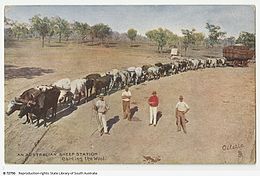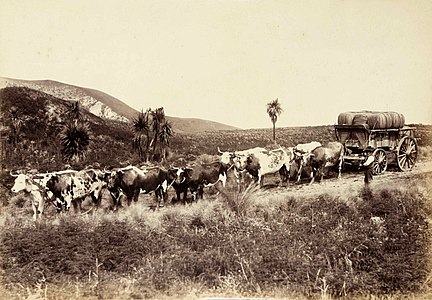Ox-wagon

An ox-wagon or bullock wagon is a four-wheeled vehicle pulled by oxen (draught cattle). It was a traditional form of transport, especially in Southern Africa but also in New Zealand and Australia. Ox-wagons were also used in the United States. The first recorded use of an ox-wagon was around 1670,[citation needed] but they continue to be used in some areas up to modern times.
Design
Ox-wagons are typically drawn by teams of oxen, harnessed in pairs. This gave them a very wide
The wagon itself is made of various kinds of wood, with the rims of the wheels being covered with tyres of
Most of the load-carrying area was covered in canvas supported by wooden arches; the driver sat in the open on a wooden chest (Afrikaans: wakis).
- Examples of ox-wagons
-
Bullock wagon carrying wool in New Zealand, c1880.
-
Bullock Team drawing II Ton Marshall Engine (Australia early 20th century)
-
Ox-wagon with four wagon wheels.
-
Ox-wagon front axle assembly.
Australia
Bullock wagons were important in the colonial history of Australia.
Many Australian country towns owe their origin to the bullock teams, having grown from a store or shanty where teams rested or crossed a stream. These shanties were spaced at about 12-mile (19 km) intervals, which was the usual distance for a team to travel in a day.[5]
South Africa
The
The ox-wagon could also be disassembled in five minutes by hitting out four pegs on the wheels, then lifting the top of the wagon in seven pieces and carried by four people over rough terrain or across rivers. The ox-wagon could also twist 40 degrees which made it ideal for traversing difficult surface areas. The wheels of the ox-wagon were painted in red lead paint which acted as an excellent water repellant. Various flower and ornament designs were also painted on the wagons and the chests the wagons carried, making them look very colourful.[7]
Often the wagons were employed as a mobile fortification called a
After the discovery of gold in the
Afrikaner symbolism
In
Gallery
- South African cultural heritage
-
Relief of an ox-wagon on the laager wall
-
A replica kakebeenwa located in theKruger Museum
-
The Voortrekker Monument in Pretoria is encircled by a wall depicting Ox-wagons
See also
- Bullock cart (ox-cart)
- Bullocky
- Carriage
- Chuckwagon
- Conestoga wagon
- Oxbow
- Wagon
References
- ISBN 0-349-10449-2.
- ^ The Australian Encyclopaedia. The Grolier Society. Halstead Press, Sydney.
{{cite book}}: CS1 maint: others (link) - ^ "Annual Berry Show". www.berryalliance.org.au. Archived from the original (PDF) on 9 December 2012. Retrieved 3 February 2022.
- ISBN 0-7301-0040-5.
- ^ "Chisholm, Alec H.". The Australian Encyclopaedia. Vol. 2. Sydney: Halstead Press. 1963. p. 181. Bullock-driving.
- ^ Davie, Lucille. "Step into a wagon and go back 200 years". The Heritage Portal. Retrieved 9 October 2018.
- ^ Davie, Lucille. "Step into a wagon and go back 200 years". The Heritage Portal.
- ^ Williams, Basil (1946). Botha Smuts And South Africa. London: Hodder And Stoughton. pp. 160–161.







